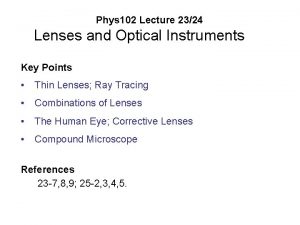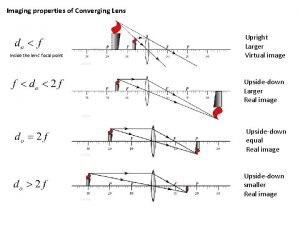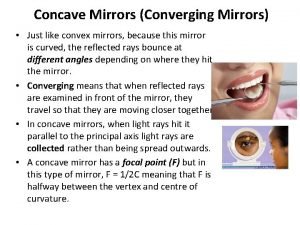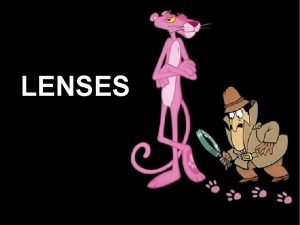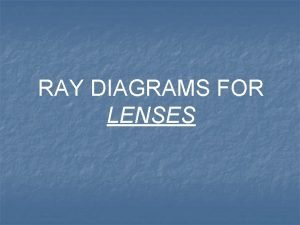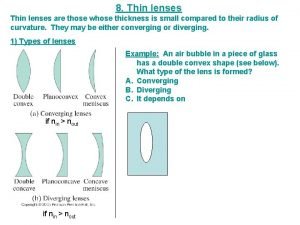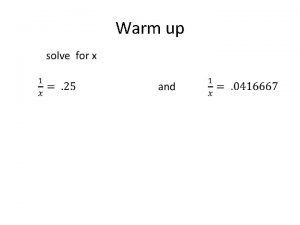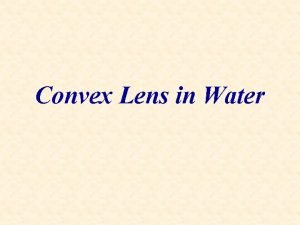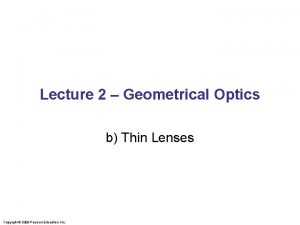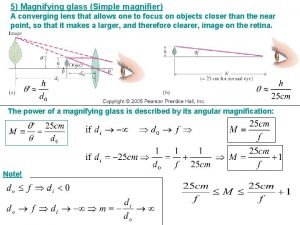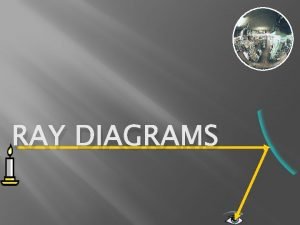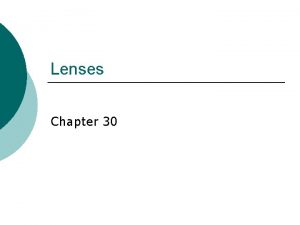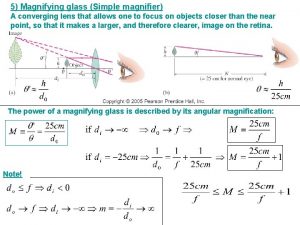Imaging properties of Converging Lens Inside the lens










- Slides: 10

Imaging properties of Converging Lens Inside the lens’ focal point Upright Larger Virtual image Upside-down Larger Real image Upside-down equal Real image Upside-down smaller Real image

Method one: How to estimate the focal length? Converging lens in air will focus a collimated beam travelling along the lens axis to a spot (known as the focal point) at a distance f from the lens, i. e. , an object at an infinite distance (as represented by a collimated beam of waves) is focused to an image at the focal point of the lens. n Choose one object at an infinite distance(door); n Move your converging lens, make sure there is a sharp image on the screen; n Measure the distance from screen to the lens. n It’s about 10 cm.

Method two: Auto collimation approach The optical system: • the object(the light) • the converging lens • The mirror n Fixed the position of object; n The converging lens posited near the focal point; n Move the mirror; n The image reflected by the mirror and the object should have the same center; n The object distance is just the focal length. image object

Method three: Bessel approach Derivition of the equation: The first time: The second time: And we also know: n Fixed the position of object and the image screen; n The distance D between these two should bigger than 4 f; n Move the converging lens, till you see a sharp image; n Write down the di 1 & do 1; n Move the converging lens again, you will see another sharp image; n Write down the di 2 & do 2; n d= di 2 - di 1 , D= di 1 + do 1. n Pay attention: the distance D should keep invariant.


Optional: Measure the focal length of a diverging lens n Put the light outside the focal point of converging lens; n Move the image screen till you find a very sharp and smaller image, measure the image distance di; (between the converging lens and the image screen) n Put a diverging lens on the opposite side of the light, measure the distance between these two lens, we can call it d; n Move the image screen till you find a very sharp and larger image, measure the new image distance v; (between the diverging lens and the image screen); n For the diverging lens: • The object distance is u=(di-d) • The image distance is v • And then you can get the expression of its focal length:

The latent heat of vaporization of liquid nitrogen Initial temperature: θ 1 ( room temperature) copper Finial temperature: -195. 8℃ Cup ∆m initial height of LN final height of LN How much heat energy has transferred from the “hot” copper to LN?

Calculation of the transferred energy: a) Directly For this method you should know the expression of specific heat of copper in the temperature range from room temperature to the temperature of liquid nitrogen (-195. 8℃): Ccu(T), which is the function of temperature. b) Indirectly n Temperature from -195. 8℃ to θ 3 : Transfer the “cold” copper to the aluminum cup of water (2/3 volume) with initial temperature θ 2, Copper absorbed energy from water and it’s temperature will increase to θ 3. In this process • the energy provided by water is Cwmw(θ 2 - θ 3 ) • the energy provided by aluminum cup is Cama(θ 2 - θ 3 ) • the energy provided by copper stirrer is Ccmc(θ 2 - θ 3 ) n Temperature from θ 3 to θ 1: Ccumcu(θ 1 - θ 3 ) n Total enerfy:

How the get the value of ∆m n Try to linear fitting the line ab & line cd from the data you measured; n Fine the midpoint of tb & tc , we will call it te; n Substitute the value of te into the function of line ab, and get the mass of mf; n Substitute the value of te into the function of line ab, and get the mass of mg ; n The value of ∆m=mf-mg. n Pay attention: air & copper air

